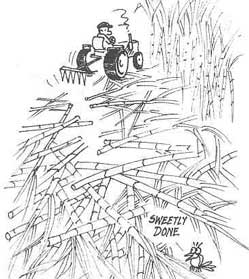Seven in one
 sugarcane farmers can look forward to the recently developed tractor-drawn sugarcane cutter-planter which has been designed to simplify the cane planting process. Developed at the Indian Institute of Sugarcane Research ( iisr ), Lucknow, the two-row, tractor-drawn sugarcane cutter-planter is capable of performing seven operations, involved in cane planting, at a time.
sugarcane farmers can look forward to the recently developed tractor-drawn sugarcane cutter-planter which has been designed to simplify the cane planting process. Developed at the Indian Institute of Sugarcane Research ( iisr ), Lucknow, the two-row, tractor-drawn sugarcane cutter-planter is capable of performing seven operations, involved in cane planting, at a time.
These include: sett cutting, or the cutting of seed cane into pieces, furrow opening, sett placement, fertiliser dispensing, insecticide application, soil covering and tamping where a tamping roller is used to press the blanket of soil lightly to conserve the soil moisture. The whole process of cutting the setts, storing and then using them requires an enormous amount of labour and mechanical energy. The earlier process led to bud damage due to excessive handling, desiccation of setts and loss of soil moisture.
The conventional method of sugarcane planting in India is essentially manual. Use of implements is limited to ploughs and planters. Efforts earlier at the institute were directed towards developing individual machines for cutting setts and planting them in the soil. Later, the idea of building a comprehensive machine took shape, which evolved into the sugarcane cutter-planter.
The improved iisr tractor-drawn sugarcane cutter-planter, priced at Rs 22,000 approximately, economises the whole cane planting operation. In fact, the 35-hp tractor saves 142 human-hours per hectare. The various operating units of the new device include the furrow opening unit which consists of two conventional ridger bodies mounted on a sturdy frame. The inter-row spacing of the ridges can be changed from 60 to 90 cm.
The sett cutting unit consists of two blades mounted on a rotating disc, a guiding ring and a chute for each row. Whole canes are fed manually through the guiding ring to the rotating blades. The fertiliser dispensing unit consists of a simple metering device and includes an agitator and four holes for the dispensing of a calibrated amount of fertiliser. The unit can success fully handle urea or di-ammonium phosphate. A chemical solution tank for applying insecticide and fungicide solution over setts and furrow soil serves as the. chemical application unit. The sett covering unit consists of shovels and a tamping roller.
The planter was put on test trials in the sandy loam soil of the iirs farms. Its performance was then compared with that of the semi-automatic planter and conventional planting techniques. Total human-hour requirement for planting one hectare field by using this technique was 18, whereas it was 160 in case of conventional planting and 44 in case of planting with semi-automatic planter. Further, bud germination using the cutter-planter was 35-40 per cent better than conventional planting. Apart from this, the modified planter also saves time, avoids desiccation and conserves soil moisture.
Related Content
- Order of the Supreme Court regarding Seven Wonders Park along the Ana Sagar Lake in Ajmer, Rajasthan, 17/03/2025
- Order of the Punjab and Haryana High Court regarding unauthorized constructions in areas of DLF City, Gurugram, Haryana, 13/02/2025
- Report by the Central Groundwater Authority on the presence of arsenic and fluoride in India, 18/11/2024
- Indian states' electricity transition (SET): 2024
- Compliance report by Andhra Pradesh on the presence of arsenic and fluoride in the groundwater of the state, 29/03/2024
- State energy efficiency index 2023
